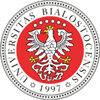Proszę używać tego identyfikatora do cytowań lub wstaw link do tej pozycji:
http://hdl.handle.net/11320/18963| Tytuł: | Przez moje okno. Lwowskie kroniki i felietony Gabrieli Zapolskiej |
| Inne tytuły: | Through My Window. Lviv Chronicles and Feuilletons by Gabriela Zapolska |
| Autorzy: | Górzyńska, Małgorzata |
| Słowa kluczowe: | Gabriela Zapolska dziennikarka reporterka Lwów stała rubryka w dzienniku Przez moje okno journalist reporter Lviv permanent column in the newspaper Through My Window |
| Data wydania: | 2022 |
| Data dodania: | 7-paź-2025 |
| Wydawca: | Collegium Columbinum SJ |
| Źródło: | Zapolska międzynarodowa. Seria I: Biografia, estetyka, recepcja, red. nauk. Anna Janicka i Piotr Biłos, Kraków – Białystok 2022, s. 247-276 |
| Seria: | Przełomy/Pogranicza: Studia Literackie;50 |
| Konferencja: | I Międzynarodowa Konferencja Naukowa „Gabriela Zapolska. Biografia – Estetyka – Idee", Białystok–Paryż–Lwów, 24 września 2021 r. |
| Abstrakt: | Gabriela Zapolska – a novelist, dramatic author, actress – these are the terms which appear in biographical notes about her. Sometimes she is referred to as a theatre reviewer, rarely a journalist, reporter. Meanwhile, considering her journalistic interests, moral observations, and the topics she took up in her columns, her entire work, both in prose and dramatic, has grown. She published in the leading magazines of the Warsaw, Krakow and Lviv press – including the “Kurier Warszawski”, “Kurier Codzienny”, “Przegląd Tygodniowy”, “Gazeta Krakowska”, “Życie”, “Słowo Polskie”, “Nowe Słowo Polskie”, “Ilustracje Polskie”, “Wiek Nowy”. The nineteenth century was a time of intensive development and diversification of the press, while it became the main way to shape and express public opinion. The column and weekly newsletters were a permanent element of various types of periodicals, and the most outstanding contemporary writers of Zapolska were authors of journalistic materials systematically supplied to the editorial office of magazines. In her long-term and varied cooperation with magazines, the cooperation with “Przegląd Tygodniowy” was extremely important for the development of Zapolska’s personality and writing skills, and the magazine’s long-time editor Adam Wiślicki saw in her great potential and journalistic talent, he trusted her and gave her the opportunity to develop a great freedom of action and writing. The turning point for her came in 1889, when she left for Paris as a correspondent for “Kurier Warszawski” during the Universal Exhibition. From there, she sent her first correspondence. With time, after the Exhibition was closed, she was supplied with subjects for columns and reportages by the Parisian streets, moral scandals, beauty contests, fashion, literary and theatre news. In 1900, she started working in “Słowo Polskie”, the largest Galician daily, being the only woman in the editorial team. She had a permanent column in the newspaper, “Through My Window”. When taking up work in the editorial office, she focused mainly on social problems that bothered her, especially regarding women, their rights, but also duties, education, paid work, the issue of bringing up and caring for children; she was interested in the fate of single mothers, servants exploited by their employers, health and hygiene – she was occupied with all matters of everyday life. Sensitive to the misfortunes of common people, strict in her view of society’s indifference to these problems, in her columns she developed and articulated her social program – from educating young girls, preparing them for work, to motherhood, to caring for and raising a child, to showing the way and the possibility of helping in situations in which such help was needed. In the collection of the Adam Mickiewicz Museum of Literature in Warsaw, there are two unpublished letters written by Gabriela Zapolska, very important in the aspect of the problems raised by the writer. The first of them, to Józefa Kulińska, Zapolska’s friend from school years, is connected with the activity of the Parent Association in Lviv, a society taking care of children and youth, whose task was to eliminate the gaps in family upbringing. The union cared for children from poor families, provided hot meals, helped with learning, organized games, trips, and took care of the children’s physical development. Zapolska joined the program of the union not only with her writing, but also by participating in various charity, cultural and artistic events like “Christmas Meetings” for children organized by the Parent Association. As a drama writer and actress, aware of the educational role of theatre, she fought for the availability of performances for the poorest. The second letter is to Władysław Bogusławski, a theatre critic, author of a favourable review of the Zapolskas play “The Four of Them”. In her letter, Zapolska mentions Ellen Key, a Swedish writer, activist of the women’s movement, the author of “The Century of the Child “ – a position considered to be one of the first in talking about issues related to the upbringing and education of children. A child, his fate, caring for him and raising him is a special topic for Zapolska. Both lists are part of Zapolska’s social program, which she consistently conducted in her Lviv columns. She treated the journalist’s work as a mission. She had well-established views and a precise list of topics that were her interests. Her essays, in terms of content close to the assumptions of Positivism, showed the upcoming modernist movement in their form. In short, naturalistic descriptions of human suffering, there was a place for poetic impression, irony, satire, and sometimes humorous comparisons. They combined a factual, journalistic report with a literary description. Her articles, the consistent and coherent social program contained in the chronicles and columns, in my opinion, are not surpassed by the chronicles of Bolesław Prus, the most outstanding journalist of the era. Mature, aware of her journalistic value and skills, Gabriela Zapolska can be undoubtedly described as a pioneer of committed women’s journalism. |
| Afiliacja: | Muzeum Literatury im. Adama Mickiewicza w Warszawie |
| Nota biograficzna: | MAŁGORZATA GÓRZYŃSKA – kustosz Muzeum Literatury im. Adama Mickiewicza w Warszawie. Absolwentka Wydziału Polonistyki Uniwersytetu Warszawskiego. W styczniu 1989 roku podjęła pracę w Muzeum Literatury im. Adama Mickiewicza w Dziale Rękopisów, zdobywając doświadczenie w opracowywaniu archiwów rękopiśmiennych w działalności wystawienniczej. Od lipca 2009 pracuje w Bibliotece Muzeum, zajmując się opracowaniem i udostępnianiem zbiorów, prowadzi czytelnię. W roku 2007/2008 ukończyła studia muzeologiczne na Podyplomowym Studium Muzeologicznym Wydziału Historycznego Instytutu Etnologii i Antropologii Kulturowej UJ. W latach 2019–2021 ukończyła studia podyplomowe w Instytucie Sztuki Polskiej Akademii Nauk w specjalizacji „historia sztuki i współczesna kultura wizualna”. Dorobek wystawienniczy: – Asystent i współkomisarz wystawy Warszawa „Lalki” Bolesława Prusa, zrealizowanej przy współpracy z Muzeum Historycznym m. st. Warszawy oraz Archiwum Akt Nowych, prezentowanej w Muzeum Literatury im. Adama Mickiewicza w Warszawie w 2006 roku. – Komisarz tejże wystawy z ramienia Muzeum Literatury im. Adama Mickiewicza w Warszawie, w Muzeum Szlachty Mazowieckiej w Ciechanowie, gdzie wystawa była także prezentowana. – Autorka i komisarz pokazu rękopisu wiersza Juliusza Słowackiego Uspokojenie w Muzeum Literatury im. Adama Mickiewicza w Warszawie. – Współautorka scenariusza (części literackiej i biograficznej) i kurator wystawy Gabriela Zapolska. Zbuntowany talent, zrealizowanej we współpracy z Muzeum Teatralnym w Teatrze Wielkim – Operze Narodowej w Warszawie, prezentowanej w 2011 roku. – Autorka scenariusza i kurator ekspozycji „Pan Tadeusz”. Pokaz eksponatów ze zbiorów Muzeum Literatury im. Adama Mickiewicza”, prezentowanej w Pałacu Prezydenckim w Warszawie we wrześniu 2012 roku. – Kurator wystawy Poeta odchodzi. Tadeusz Różewicz prezentowanej w Muzeum Literatury im. Adama Mickiewicza w Warszawie od 24 listopada 2016 do końca czerwca 2017 roku. Opracowała m.in. katalogi rękopisów: Archiwum Zenona Kosidowskiego, [w:] Katalog Rękopisów Muzeum Literatury im. Adama Mickiewicza w Warszawie (t. IV, Warszawa 2002); fragment archiwum Marii Pawlikowskiej Jasnorzewskiej (listy do męża, wiersze), [w:] jw. (t. II, Warszawa 2002); spuścizna Bronisławy Ostrowskiej, [w:] jw. (Warszawa 2002); fragment archiwum Marii Kuncewiczowej, [w:] jw. (t. IV, Warszawa 2005); fragment archiwum Czesława Straszewicza (dokumenty, dokumenty rodzinne, korespondencja), [w:] jw.; Bruno Schulz – listy do Romany Halpern, [w:] jw.; artykuł Warszawa „Lalki” Bolesława Prusa, Muzeum Literatury 30 marca – 25 września 2006, [w:] „Rocznik Warszawski”, t. XXXV (Warszawa 2007); tekst do folderu wystawy Warszawa „Lalki” Bolesława Prusa (Warszawa 2006); tekst do folderu wystawy Gabriela Zapolska. Zbuntowany talent (Warszawa 2011); artykuł Adam Mauersberger. Dyrektor. Muzeolog. Wizjoner przygotowany na konferencję naukową z okazji 110-lecia Muzeum Narodowego Ziemi Przemyskiej w Przemyślu pt. Dziedzictwo Kunstkamery? Jak powstawały nasze muzea, 2 i 3 grudnia 2020. Druk w: Dziedzictwo Kunstkamery. Jak powstawały nasze muzea, s. 219–231 (Przemyśl 2020). Hobby: „podróże do Włoch” (niekoniecznie iwaszkiewiczowskie), marsze z kijkami, kultura i rzeźba ludowa. Kolekcjonuje drewniane rzeźby aniołów i malowanki na szkle. Mieszka w Warszawie. |
| URI: | http://hdl.handle.net/11320/18963 |
| ISBN: | 978-83-7624-204-1 |
| Typ Dokumentu: | Book chapter |
| Właściciel praw: | © Uniwersytet w Białymstoku, Białystok 2022 © Collegium Columbinum, Kraków 2022 © Anna Janicka i Piotr Biłos, Białystok 2022 |
| Występuje w kolekcji(ach): | I Międzynarodowa Konferencja Naukowa „Gabriela Zapolska. Biografia – Estetyka – Idee", 24 września 2021 |
Pliki w tej pozycji:
| Plik | Opis | Rozmiar | Format | |
|---|---|---|---|---|
| M_Gorzynska_Przez_moje_okno.pdf | 766,53 kB | Adobe PDF | Otwórz |
Pozycja jest chroniona prawem autorskim (Copyright © Wszelkie prawa zastrzeżone)

